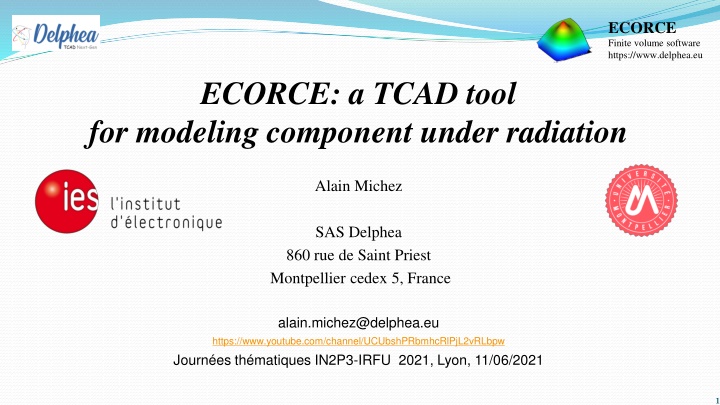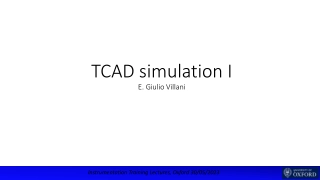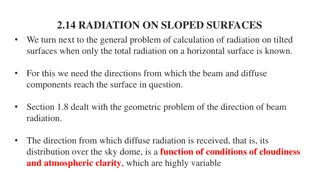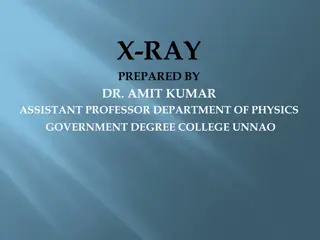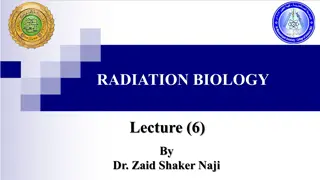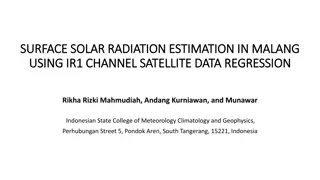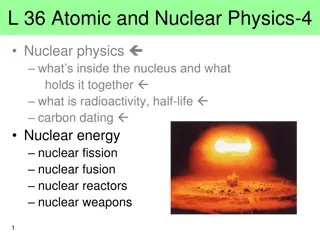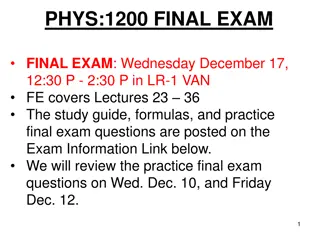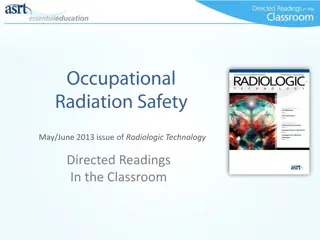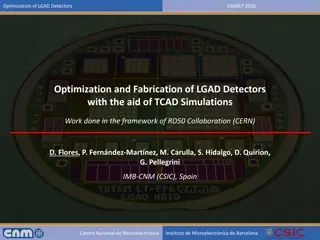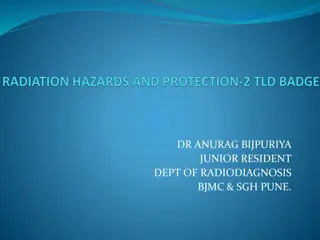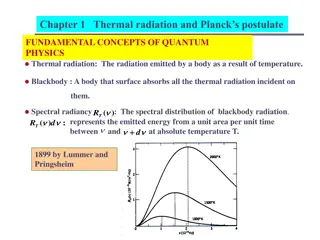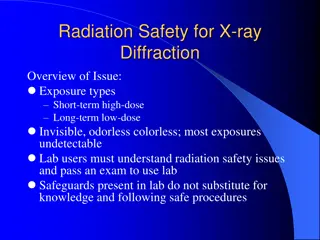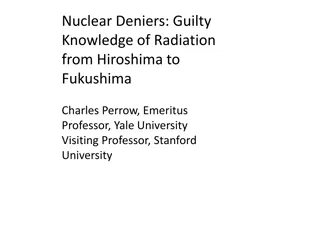ECORCE: TCAD Tool for Radiation Effects on Components
Goal of TCAD for component under radiation, importance of mesh quality, modeling single event effects, total ionizing dose modeling, TCAD goal to understand radiation-induced phenomena on components like single event effects and total ionizing dose, advantages of modeling over experiments, insight into mechanisms at play, and the special features of ECORCE for radiation effect modeling and mesh quality in TCAD.
Download Presentation

Please find below an Image/Link to download the presentation.
The content on the website is provided AS IS for your information and personal use only. It may not be sold, licensed, or shared on other websites without obtaining consent from the author.If you encounter any issues during the download, it is possible that the publisher has removed the file from their server.
You are allowed to download the files provided on this website for personal or commercial use, subject to the condition that they are used lawfully. All files are the property of their respective owners.
The content on the website is provided AS IS for your information and personal use only. It may not be sold, licensed, or shared on other websites without obtaining consent from the author.
E N D
Presentation Transcript
ECORCE Finite volume software https://www.delphea.eu ECORCE: a TCAD tool for modeling component under radiation Alain Michez SAS Delphea 860 rue de Saint Priest Montpellier cedex 5, France alain.michez@delphea.eu https://www.youtube.com/channel/UCUbshPRbmhcRlPjL2vRLbpw Journ es th matiques IN2P3-IRFU 2021, Lyon, 11/06/2021 1
ECORCE Finite volume software https://www.delphea.eu OUTLINE 1. Goal of TCAD for component under radiation 2. Importance of the mesh quality 3. Single Event Effects modeling 4. Total Ionizing Dose modeling 5. Conclusion 2
ECORCE Finite volume software https://www.delphea.eu 1. TCAD goal Understand phenomena induced by radiation on components Single Event Effects (SEE) Total Ionizing and Non Ionizing Dose (TID) (TNID) ElectroStatic Discharge (ESD) Combined effects:TID, TNID, SEE, ESD Advantages over experiments: Drawbacks: model in a reduce time long duration phenomena. not a qualification tool results reliability? fast and easy(?) results keep in mind: Garbage In, Garbage Out (GIGO) insight of the mechanisms at play It is essential to carefully check inputs and correlate modeling with experiments 3
ECORCE Finite volume software https://www.delphea.eu 1. TCAD goal: ECORCE ? Etude du COmportement sous Radiation des Composants Electroniques Similar to SENTAURUS and ATLAS Designed to ease TCAD implementation Special features Full graphical interface Control of model definition Dynamic mesh Radiation effect modeling Single event, dose and dose rate effects Multiple trapping-detrapping model in insulators, semiconductors, and at interfaces Lacks Process modeling 3D suitable for teaching (7 years effects of radiation,10 years finite element method) 4
ECORCE Finite volume software https://www.delphea.eu 2. Mesh quality TCAD modeling of component based on semiconductors and insulators, by solving differential equations: Poisson, Transport, Heat, Trapping, ?2? ??2= ? ? ? No analytical solution, solving method: Discretisation of differential equations: linear interpolation in each element Approximate solution: mesh adjusted to control the error 5
ECORCE Finite volume software https://www.delphea.eu 2. Mesh Quality Potential V4 V1 V3 Finer mesh on high gradient area improves precision of results V2 Node 2 x2 Node 3 x3 Node 1 x1 Node 4 x4 x Potential High gradient area, need to add nodes V4 V3 Coarse mesh on low gradient area reduces computation time Dynamic mesh for TCAD modeling with ECORCE , A Michez et al 2016 J. Phys.: Conf. Ser. 738 012128 V2 V1 Node 2 x2 Node 1 x1 Node 4 x4 Node 3 x3 x Low gradient area, need to remove node Complicated task difficult to design an optimized mesh by hand Should be automatically handled by the TCAD tool. Is it really so important for results precision? 6
ECORCE Finite volume software https://www.delphea.eu 2. Mesh Quality 100.00 Analytical solution: Poisson :?2? Electric charge : ? ? = ? ????? ? ? =? ?????2 ? 0.0625 m (17 nodes) ??2= ? ? Relative error (%) 10.00 ? 0.031 m (33 nodes) ? 1.00 ? ? ?+ ? 1 0.0078 m (129 nodes) ? 1 ? + 1 0.10 0.0039 m (257 nodes) ( m) Qmax (cm-3) ? (Rel.) q (C) Dynamic (77 nodes) 0.01 0.00 0.25 0.50 0.75 1.00 1018 1.6 10-19 0.02 11.9 x ( m) Relative error compared to the analytical solution as a function of the mesh size (markers: nodes of the mesh) 6.00 Potential (V) Error: 100% 62.5 nm mesh size (17 nodes) 0.3% 3.9 nm mesh size (257 nodes) 0.16% variable mesh size (77 nodes) 4.00 2.00 0.00 0 0.2 0.4 0.6 0.8 1 x ( m) Mesh quality is critical for results reliability. Potential induced by Q(x) for a 1um wide device (Analytical solution) 7
ECORCE Finite volume software https://www.delphea.eu 3. Single Event Effect ECORCE mesh corrected according to all variables, for all steps including transient modeling Essential for Single Event Effect (Example: ion effect on a negatively biased PN junction) P+ N substrate Before Ion, 678 nodes 10-10 s after impact, 11253 nodes Ion impact, 11904 nodes 10-9 s after impact, 4009 nodes 4.00 20000 As expected: 2 peaks of current (blue curve) Number of nodes ranging from 678 to 19549 (red curve) Current (A/cm) Current (A/cm) Number od nodes 3.00 15000 Number of nodes 2.00 10000 1.00 5000 Dynamic mesh improves results precision and reduces CPU time. saves engineers hours 0.00 0 1E-15 1E-13 1E-11 Time (s) 1E-09 1E-07 Current and number of nodes as a function of time 8
ECORCE Finite volume software https://www.delphea.eu 3. Single Event Effect 3 models available: Constant LET SRIM continuous LET Discontinuous model using GEANT4 25,000 20,000 LET (MeV/mm) 15,000 LET SRIM 10,000 Continuous ion track using SRIM profile 5,000 0 0 50 Range ( m) Constant and SRIM LET as a function of range Depending on the problem, the Bragg peak position in the device may matter. ECORCE is fully interfaced with SRIM and with GEANT4 Dynamic mesh is mandatory to handle discontinuous ion tracks Discontinuous ion track using GEANT4 profile 9
ECORCE Finite volume software https://www.delphea.eu 4. Total Ionizing Dose Total Ionizing dose -> electron/hole pairs generated in the whole structure Gate Drain Source N + N + Silicon charges quickly recombined/collected at the contact Oxide positive charge trapped on defects. STI STI P substrate Buried Oxide Many oxides used in all components: MOSFET, Bipolar, ... 3 models available: Fixed charge Srour model Precursor model Handle Wafer Substrate Gate Drain Source Oxides in a PDSOI structure N + N + Focus on gate oxide (100nm) shift of the threshold voltage P substrate Cross Section for charge spatial distribution Substrate Cross Section Academic transistor 10
ECORCE Finite volume software https://www.delphea.eu 4. Total Ionizing Dose: Fixed Charge Gate (5V) Example: 10 krad, Vgs = 5 V Density generated in the oxide: 7.6 1016cm-3 Estimated electric field: 0.5 MV/cm Initial separation of generated pairs: 0.5 Concentration at the interface, half of the oxide Fixed charge density applied: 7.6 1016cm-3 Threshold Voltage Shift: -1.43 V Fixed charge Easy to implement Low calculation time Does not take into account change of the electric field during irradiation Real displacement of charges in the oxide Temperature Recombination of trapped holes with electrons Thermal reemission of trapped hole 2.5E-05 Pristine Q fixed 2.0E-05 Id (A/ m) 1.5E-05 1.0E-05 5.0E-06 0.0E+00 Fast but weak method. Many phenomena are not taken into account -1 1 3 5 Vgs (V) 11
ECORCE Finite volume software https://www.delphea.eu 4. Total Ionizing Dose: Srour model O. L. Curtis Jr and J. R. Srour, The multiple trapping model and hole transport in SiO2 , J. Appl. Phys., vol. 48, no. 9, pp. 3819 3828, 1977 2 EC E Oxide wide band gap semiconductor defects inside the gap, trap charges En1... EnK 3 5 4 h Traps defined by activation energy Ep1... EpL density 1 4 5 EV 3 Phenomena taken into account electron-hole pairs generated by radiation drift-diffusion of carriers in their respective allowed band trapping of free carriers recombination of trapped carriers by free carriers of the opposite type thermal reemission of trapped carriers to their respective allowed band 2 Traps are considered to be pre-existing in the oxide 12
ECORCE Finite volume software https://www.delphea.eu 4. Total Ionizing Dose: Srour model Example: 10 krad, Vgs = 5 V Density of traps: 1019cm-3 constant in the oxide All parameters automatically calculated: Electric field Position and density of trapped charges Initial separation of generated pairs 2.5E-05 Pristine Q fixed Srour model 2.0E-05 Id (A/ m) 1.5E-05 1.0E-05 5.0E-06 0.0E+00 Threshold Voltage Shift much lower than Q fixed model: -0.71 V -1 1 3 5 Vgs (V) 9E+16 Charge density is lower with Srour model: 4 1016cm-3vs 7.6 1016cm-3for the fixed model 8E+16 7E+16 Charge density (cm-3) 6E+16 5E+16 Q fixed recombination of trapped hole with free electrons not taken into account, DVth over estimated 4E+16 3E+16 2E+16 1E+16 0 Complete model is mandatory to obtain a significant result 0.5 0.52 0.54 0.56 0.58 0.6 Interface x crosscut from interface to gate contact ( m) Gate 13
ECORCE Finite volume software https://www.delphea.eu 4. Total Ionizing Dose: fitting experimental results Experimental results N MOSFET, IRF130 batch, same datecode 70krad, 100rad/s, X-ray 3 biases Vgs : -5V, +5V et +12V 8 temperatures during irradiation: 30 C, 55 C, 70 C, 85 C, 93 C, 100 C, 130 C and 160 C Precursor model Srour model 70 30 50 90 110 130 150 30 50 70 90 110 130 150 T C T C 0 0 -1 -1 -2 -2 -3 -3 Vth(V) -4 -4 Vth(V) Exp. Vgs=+12V Exp. Vgs=+5V Exp. Vgs=-5V Fitted Points Mod. Vgs=+12V Mod. Vgs=+5V Mod. Vgs=-5V Exp. Vgs=+12V Exp. Vgs=+5V Exp. Vgs=-5V Fitted points Mod. Vgs=+12V Mod. Vgs=+5V Mod. Vgs=-5V -5 -5 -6 -6 -7 -7 -8 -8 -9 -9 Precursor model All biases/temperature correctly fitted with a single TCAD device for a given dose/dose rate 14
ECORCE Finite volume software https://www.delphea.eu 5. Conclusion Mesh design essential for results precision and realistic modeling dynamic mesh reduces TCAD implementation time SEE Quick and precise modeling thank to dynamic mesh SRIM and GEANT4 profiles available TID 3 models available choice based on the results relevance needed and computation effort accepted Quantitative prediction of TID effect by TCAD modeling Others Optimizer Customized functions (mobility, impact ionization, ) Physical model display: equations, materials caracteristics, ... Useful for teaching 15
